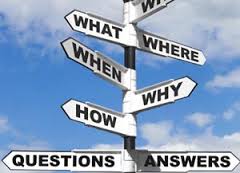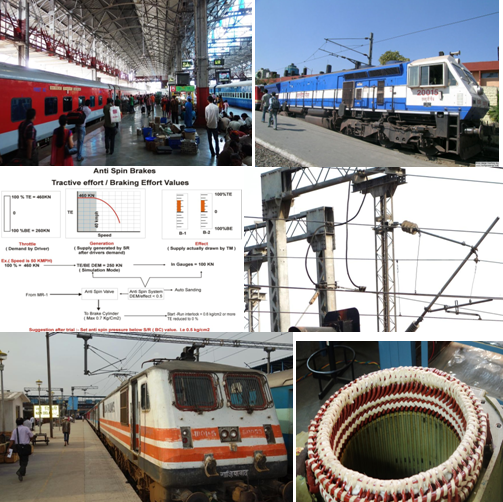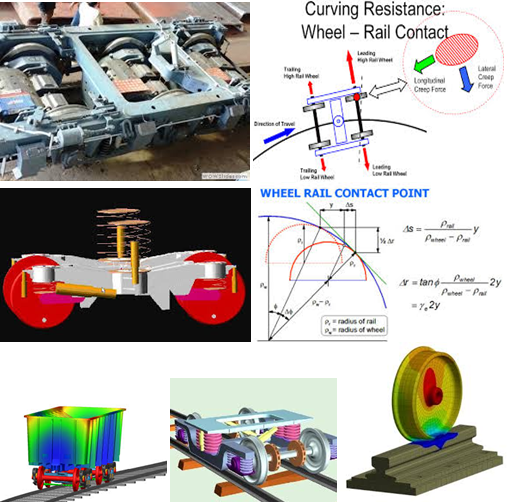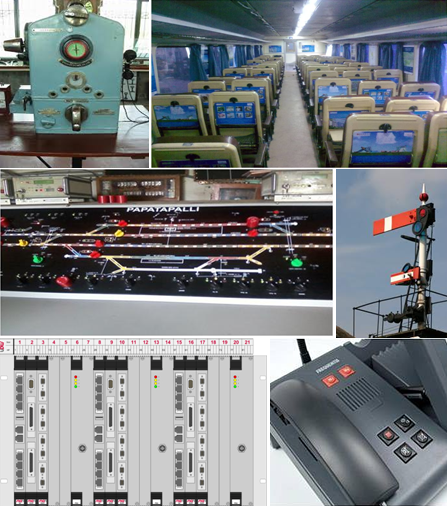University of Railways – Why, What, How and Where?
Indian Railways is planning to set up Railway University for training students in Railway technologies who later will be engaged to help to build railway infrastructure. Indian railways cannot be a silent spectator in the growth map of India, which is certainly going to rise from the present level of 5% to about 8-9% in the next 2-3 years. Indian Railway has not been able to garner an equal or better share in the growth percentage and road sector has always taken a lead in attracting the traffic because of many advantages associated with Road sector as compared to Railways. With falling crude oil prices, Govt. commitment to building highways and expressways with low gestation period, higher payload, no botheration to worry for road repairs, etc., Indian Railways is going to face very tough competition from the road. And for this reason, Indian Railway has chalked out a plan for modernization and to act as an Engine for Growth.
Rail transport wins over the road for its contribution towards sustainable development and engine for the heavy and high-speed haul, thus, have the ability to play a bigger role in the overall growth of the country. It is not just constructing the track or procurement of rolling stock essential for this, but also the qualified engineers in the field of Rail Technologies.
In order to meet the technological challenges of the steam era, Indian Railway established IRIMEE at Jamalpur with recruitment through SCRA conducted by UPSC. The Special Class Railway Apprentices (SCRA) is a unique sandwich training scheme modeled on “Catch them Young” fundamental of professional training and particularly when such needs were not met through the existing academic institutes. Presently, IR has entered with an MOU with BIT/Mesra to impart academic course of 4 years in Mechanical Engineering with training on Railways during the vacation period. Read more at the home page of http://www.irimee.indianrailways.gov.in/view_section.jsp?lang=0&id=0,294,434
Is this module not a success story? If so, scrap it otherwise replicate for all branches of engineering to catch them young and develop Railway Engineers. This will fit the target of PMO as well.
What is the prime function of Railways?
The railway has come into existence some 160 years ago, and many systems, other than the prime function of transport, developed over the period to meet the need of the hour. During the early days, education, Medical, power generation, etc. were essential for its survival and install its space in the scheme. But with country progressing leaps and bounds, Railways started debating about Core and Non-core activity and many committees were constituted to shelve the non-core activity such as education, medical, etc. But it is very difficult for a government organization to shelve any ongoing activity due to political/bureaucracy/union pressures. What to say about shelving non-core activities, our political masters have given way to the extent of announcing in Parliament for the setting of Medical Colleges at Railway land and price. Thanks to the present Govt. of deciding against it, but looking for establishing Railway University but with positive intent and not a vote bank politics.
However, the directives of establishing Railway University is top driven (from the office of PMO) and not on the basis of need base analysis. This  demand is neither initiated from Railways nor Industry, but when the directives issued from the PMO, then who can so ‘No’. There is also no possibility of bureaucracy going to PMO and requesting that establishing of University will be considered based on the in-house brainstorming on Why, What, How and Where?
demand is neither initiated from Railways nor Industry, but when the directives issued from the PMO, then who can so ‘No’. There is also no possibility of bureaucracy going to PMO and requesting that establishing of University will be considered based on the in-house brainstorming on Why, What, How and Where?
Why there is a need?
- Rail Technologies are different and are not taught in any University except a few references to explain a concept. Some institutes conduct elective subject in the final year in Electrical Traction but there is no course in Permanent Way or Rolling Stock etc. There are not many takers of these courses because not offering any higher weighting towards job opportunities. There is no technical literature available on Railways as study material. One book was written by an author named Mr. H. Pratab in the ’70s (period of Excitron and Ignitron tubes) with the joint effort of Railways and Mr. H. Pratab and still a reference and study material till date.
- The important issue of Rail technology not taught anywhere is Rail-Wheel interaction and, in fact, there is barely any research in this field in India including Indian Railways. All other issues or technological aspects are taught in one or the other form in Graduate or Post Graduate classes. It may not be possible for any Engineering Institute to set up a research facility in this area, requiring a huge investment of setting up test track, the different type of rolling stock and locomotives, signaling system, etc. There is a sanctioned work for setting up of the test track at RDSO since long, but could not be materialized till date is an indication of the problem associated with establishing test laboratories.
- RDSO has established many chairs with IIT for different research works with flip-flop stories.
- Railway University will not serve the determination unless research work is also associated with it. It is not the lectures important, but also the well-equipped laboratories for the student to apply themselves to have a practical feel of what is different for Railway. Is it not a fact that when technologies are available off the shelf abroad, then why repeat the research work in India. With this being the underlying current in Railways, no effort has been made to start technical education and research work in the field of Rail Technologies.
- Technologies are available off the shelves, but knowledge of what goes in the building of a technology (source code) is necessary for carrying out modifications, innovations, value engineering, up-gradation, etc. For this purpose, what Indian Railway has done so far is popularly called “Jugad” but it has not very successful in the long term. Can anybody believe that Indian Railway had not been able to solve the problem of jerking in LHB coach train (built in India with the transfer of technology from Germany) and non-development of self-generating variant coach for LHB design for the last 20 years?
- Railways shall co-opt PSUs like Metro Railways, DFC, IRCON, RITES, reputed industries like BHEL, BEML, SAIL, Bombardier, Alstom, Siemens, L&T, etc., and form a grand alliance so that the University of Railways shall serve all concerned associated with Railway Transport in any way. The technologies of Rail-wheel interaction is common irrespective of the umbrella they working in. Most importantly, the grand alliance will help in having a long list of visiting faculty from experts from the industry which otherwise difficult to get.

How Railway Engineers are trained presently?
Indian Railway recruits Engineers through Engineer Service Examination (ESE), called Group A service every year, held by UPSC possessing Degree level education. Recruitment of Senior Section and Junior Engineer called Group C service is conducted by RRB possessing Degree and Diploma level education.
Group A service engineer undergoes two years training at the nominated training institute in respective discipline. The training schedule includes lectures at the institutes and visits to the field for practical experience. The training institutes are well equipped and developed over the period with excellent infrastructure to cater to the need of the time. One can visit the website of the respective institute to have a fair idea about the infrastructure that exists there. The institutes are National Academy of Indian Railways at Vadodara (formerly Railway Staff college), Indian Railway Institute of Civil Engineering-Pune, Indian Railway Institute of Electrical Engineering-Nasik, Indian Railway Institute of Signal Engineering and Telecommunication – Secunderabad, Indian Railway Institute of Mechanical and Electrical Engineering and Indian Railway Institute of Traffic Management-Lucknow.
It is important for the Railway administration to check the utilization of the training infrastructure at these institutes and a dismal picture will confirm the apathy towards sparing officers for training even though the need is acknowledged at the highest level. This check will confirm the availability of spare capacity at these institutes.
Group C service, SSE/JEs also undergoes training at the nominated training institute, but not monitored by a centralized agency and even if a data is to be compiled, it will again be a dismal picture. Most preferred attitude towards this category of human resource is “On the Job Training”
What will be the Course Content
In order to meet the pressure of PMO, Indian Railways is going to sign an MOU with IIT/KGP for two year Postgraduate course in ‘Railway Engineering and Management’ from the session 2015-16. The syllabus for the course yet to be finalized.
This will not suffice, as the directive is to have a “University of Railways”. For this, Indian Railways have entered into a consultancy contract with EdCIL (a consultancy arm under Ministry of Education) to suggest ways to set up the University on the lines similar to Railway College of China. ( http://www.jrtr.net/jrtr07/f22_che.html) How it takes the shape, the future will only decide.
This is now the time that Indian Railway shall acknowledge the need of ‘Railway Technology’ as a specialized branch of Engineering with the eligibility of graduate engineering from any branch of engineering and the syllabus shall include;
- Rail-Wheel interaction: Railway Vehicle Dynamics, Railway Vehicle Running Gear, Wheel-Rail Contact, Track Gauge and Geometry, Railway vehicle derailment and prevention, Longitudinal Train Dynamics, Noise vibration, Instrumentation of Railway Vehicle, simulation studies and assessment.
- Electric Traction: Traction Distribution, Overhead Equipment, Power Drives, Three Phase Traction Motor, Current Collection
- Signalling Systems, Utilisation of section capacity, communication, etc.
What are the job opportunities?
In order to popularise the course, it is but obvious to explore job opportunities for the postgraduates opting for postgraduate course in Railway Technologies
Why a student show interest to join this course will depend only on the job opportunities offered by Indian Railways and Associated Industries. Presently, there is no incentive for any Railway related specialized course in the competitive examination system for recruitment in Group A and Group C service. The rider sometimes appearing in the advertisement like candidates possessing a diploma in IRT, P-way, etc. will be given preference is only cheating with the candidates. See below the RRB advertisement with a rider that “Two-year experience in the reputed hotel will be a desirable qualification” when the examination is only one stage. In that case, how the experience will matter, only GOD knows?

The following may help
- Recruit them on contract basis for undertaking research type work at RDSO or Production Unit or Training Institutes on lines followed by Indian Railways for Medical Practitioners.
- Fix norm to have a specified number of Post Graduates in “Railway Technologies” on the roll of an industrial unit depending upon manufacturing and supplies of railway related production
- 6 months training programme tied up with Railway University abroad and expenditure shared by student and Railways.
Where to have the University of Railways?
The plan is to locate the University at a place which is well-connected with Rail, Road, and Air. There is no dearth of cities but the problem will start for the availability of land and creation of infrastructure. Classroom infra-structure gets created very fast one should not forget that the problem lies in establishing ‘stand-alone’ laboratories for the students, and therefore, it is in the fitness of things that it shall be associated with either RDSO or NAIR. Besides cutting down on cost and time to build, the following advantages will also add on the system:
RDSO, Lucknow
- A metropolitan city very well connected by Rail/Road/Air
- Railway related research laboratories are readily available and can be improved upon based on funds earmarked for University of Railways
- Railway related technical material is readily available for sharing
- Railway problems in the knowledge domain of RDSO are shared with the University of Railways for the students to take up as projects
- Practical experience of Railway Technologies is easily available with the experts working at RDSO and their services utilized as Visiting Faculty.
- Facilities like stadium, auditorium, Library, Laboratories, Test Track, Badminton, Tennis, Swimming Pool, Rest House, and other related infrastructure can conveniently be shared.
NAIR, Vadodra
- A metropolitan city very well-connected by Rail/Road/Air
- NAIR shall tie up with all other Indian Railway Institutes of a different branch of Engineering for sharing classroom, teaching faculty, model rooms. The students will undergo an academic session of three months at each of these institutes.
- Visiting faculty from Railways arranged.
- Railways shall agree to compensate for the expenses of rail travel.
And finally
Beginning shall be made with a 2 years post-graduate degree in Railway Engineering and Management in collaboration of Railway infrastructure and academic faculty of prominent engineering institute with an annual take of about 50 students. Is there a real need of Railway University shall be decided based on the experience gained and feedback.
Indian Railway may continue in the present state indefinitely without any problem. But for High Speed and Heavy Haul, it will not be a success story without in-house research facilities to sustain the pressure of new technologies, innovations, cost, sustainability and advancements. This is the right time that Indian Railways shall redefine its aim of setting Academic and Research Facility with a purpose to collaborate Education and Research. It should not be acted upon just because it is the PMO monitored project bu a need for the survival of Railways.
You may also like:
- Why IR passenger traffic heading south?
- Why no steps to digitize issue of free travel pass…
- ‘Rescue’ Indian Railway passenger business through statistical indices ‘RSKU’
- Average speed of freight train over Indian Railways
- Where has 150 millions Indian Railway passenger gone?
- Mechanized measurement and inspection – a help to cut down…


